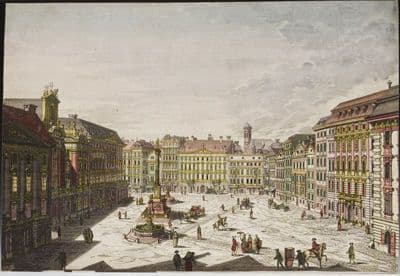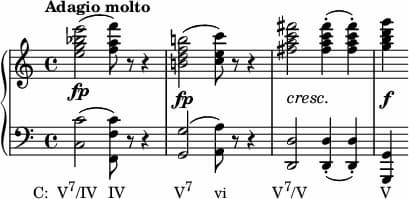During his teenage years in Bonn, Ludwig van Beethoven sketched an incomplete draft for a passionate symphonic movement in C minor. Dating from between 1790 and 1792, the draft was never brought to fruition, and it took Beethoven almost another decade before he was ready to step in front of an audience with the premiere of his First Symphony, Op. 21.

Beethoven famously stated that he learned absolutely nothing from Haydn
The premiere performance took place on 2 April 1800 in a public concert organized by the composer. The program included several movements from Haydn’s Creation, a Mozart symphony, piano improvisations, and it concluded with the Symphony No. 1. A scholar writes, “Beethoven effectively presented a tribute to the defining figures of the Classical era while staking claim to his own place in a new century of music. The concert juxtaposed the inherited styles of his predecessors and models to his own musical personality.” And a contemporary reviewer called the evening “the most interesting public concert for a long time.”
Ludwig van Beethoven: Symphony No. 1 in C Major, Op. 21,”Adagio molto-Allegro con brio”

Vienna in 1790
Beethoven introduced himself to the city of Vienna by showcasing his talents as a pianist and gradually gained control over the Viennese style. Initially, however, Beethoven wasted no time seeking out Joseph Haydn. The apprenticeship lasted from the end of 1792 until 1794, and Beethoven famously stated that he learned absolutely nothing from Haydn, and immediately contradicted himself in his first piano sonatas and subsequently in his first symphony. Haydn was a central figure in the evolution of the symphony as it mirrored the demands made of music in the Age of Enlightenment. Frequently called the “Father of the Symphony,” it was Haydn who initiated a process of liberalization that allowed the symphony to escape its roots, located both in the operatic overture and in occasional music. Beethoven drafted his First Symphony in 1799, with sketches for the concluding movement dating back to 1795. The work immediately shows the indebtedness to Haydn, yet it almost subconsciously is looking forward to the integration of dramatic and psychological elements.
Ludwig van Beethoven: Symphony No. 1 in C Major, Op. 21, “Andante cantabile” (Vienna Philharmonic Orchestra; Nikolaus Harnoncourt, cond.)

Beethoven’s Symphony No. 1
The slow introduction to the first movement is similar to various openings by Haydn. However, it begins with the wrong chord, a dominant seventh in the key of F major, rather than the expected C major. A contemporary critic immediately took Beethoven to task by declaring “such a beginning is not suitable for the opening of a grand concert in a spacious opera house.” The “Allegro con brio” does unfold with the expected poise and formal clarity demanded by Classical convention. However, there is decided restlessness in the rising of the opening melodic lines in the violin, and the overall urgency of the movement gives testament to Beethoven’s emerging compositional voice. In many ways, the mature Beethoven lurks just beneath the surface of this first symphony in its subtle details, notwithstanding its general similarity to the style of the two earlier giants of the period.
Ludwig van Beethoven: Symphony No. 1 in C Major, Op. 21, “Menuetto” (Chicago Symphony Orchestra; Georg Solti, cond.)

Beethoven’s Symphony No. 1, first edition
A courtly melody, motivically derived from the first theme of the opening movement, initiates the tranquil “Andante.” Treated in a fugal manner, this theme playfully alternates with a countermelody in the celli, with all this cleanly executed counterpoint paying homage to Beethoven’s study of counterpoint with Haydn. Although titled “Menuetto,” the third movement is clearly a “Scherzo” in tempo and spirit. In the words of a critic, “Beethoven manages to avoid banality, though, with lightning-quick shifts of mood, by turns forceful, elegant, sly, and boisterous.” Unhurried ascending scale fragments provide the humorous introduction to the concluding “Allegro.” Once the violins reach the octave, the movement bursts forth with seemingly boundless energy and the occasional harmonic and contrapuntal surprises. Donald Tovey called Beethoven’s first essay in the genre “a farewell to the eighteenth century.” And while it is a seemingly light-hearted work, it contains the incipient stages of a musical process that decidedly looks ahead to the exploration and extension of the tonal range. As Robert Schumann commented, “do not seek Beethoven’s genius in his last symphony, you can easily find it in his first.”
For more of the best in classical music, sign up to our E-Newsletter
Ludwig van Beethoven: Symphony No. 1 in C Major, Op. 21, “Adagio-Allegro Molto”

Interesting and enlightening commentary